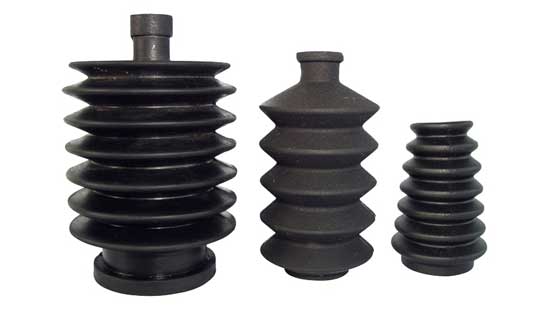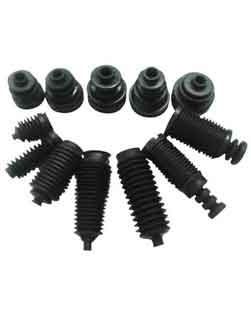The molding of rubber and elastomeric compounds is done by forcing the material into a shape by using heat and pressure. Rubber can be molded by compression, transfer and injection methods. Injection or liquid injection molding is a process of molding rubber parts.
The process
In this process, a part of the configuration is cut into a series of metal
plates that are stacked to form the mold. A plate is added where the
injection nozzle introduces material into the sprue system and from there
into the cavity. To form the rubber component, the heated mold plates are
closed and the material is injected into the cavity through the nozzle of
the injection. This can be screw system, ram system or combinations of both.
The uncured rubber is then squeezed through the system whether hot or cold
into the cavity which forms the rubber component. The injection system is
set up in such a way to deliver amounts of material to the cavity, and the
sprue system is set up so that no excess material is lost.


Applications
Rubber injection molding lead to the formation of various rubber injection
parts which are used in diverse markets including:
- Automotive
- Medical
- Government
- Appliance
- Construction
- OEM industrial
- Hydronics industries etc.
Types of rubber used in injection parts
Uses of rubber injection parts
- Medical parts
- Industrial parts
- Vehicle parts
- Motorcycle parts
- Electronics parts
- Gasket rubber
- O-rings
- Anti Vibration Mountings
- Automobile Rubber Products
- Calendered Rubber Products
- Extruded Rubber Products
- Medical Rubber Products
- Metal Bonded Components
- Rubber Adhesives & Sealants
- Rubber Ball
- Rubber Bands
- Rubber Beading
- Rubber Bearing
- Rubber Belt
- Rubber Buckets
- Rubber Bullets
- Rubber Cable
- Rubber Coating
- Rubber Duct
- Rubber Expansion Joints
- Rubber Flooring/Matting
- Rubber Footwear
- Rubber Gloves
- Rubber Injection Parts
- Rubber Lining
- Rubber Magnets
- Rubber Molded Products
- Rubber Pads
- Rubber Rollers
- Rubber Stopper
- Rubber Suit
- Rubber Track
- Rubber Valve
- Rubber Balloon
- Rubber Stamps
- Rubber Fenders
- Acrylic Rubber (ACM)
- Butadiene Rubber (BR)
- Butyl Rubber (IIR)
- Chlorosulfonated Polyethylene(CSM)/ Hypalon
- Ethylene Propylene Diene Monomer
- Fluoroelastomers (FKM)/Viton
- Isoprene Rubber (IR)
- Nitrile Rubber (NBR)
- Perfluoroelastomer (FFKM)
- Polychloroprene (CR)/Neoprene
- Polysulfide Rubber (PSR)
- Silicone Rubber (SiR)
- Styrene Butadiene Rubber
How to Make a Custom Rubber Stamp?
Whenever designing a custom stamp for your company, never compromise on its quality because in the end it is the most...
Read MoreLatex and Silicone Rubber Tubing - A Comparison!
Many industries use rubber tubing for various purposes. In fact, various types of rubber tubing are used for different applications...
Read MoreSilicone vs Acrylic Adhesive- A Comparison
Silicon and acrylic adhesives are those rubber adhesives that are widely used in Polyimide tapes. In fact, the polyimide...
Read More

